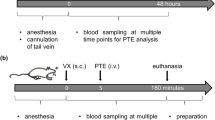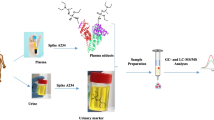Abstract
We herein present for the first time the phosphylated (*) tetrapeptide (TP)-adduct GlyGluSer198*Ala generated from butyrylcholinesterase (BChE) with proteinase K excellently suited for the verification of exposure to toxic organophosphorus nerve agents (OPNA). Verification requires bioanalytical methods mandatory for toxicological and legal reasons. OPNA react with BChE by phosphonylation of the active site serine residue (Ser198) forming one of the major target protein adducts for verification. After its enzymatic cleavage with pepsin, the nonapeptide (NP) PheGlyGluSer*AlaGlyAlaAlaSer is typically produced as biomarker. Usually OPNA occur as racemic mixtures of phosphonic acid derivatives with the stereocenter at the phosphorus atom, e.g. (±)-VX. Both enantiomers react with BChE, but the adducted NP does not allow their chromatographic distinction. In contrast, the herein introduced TP-adducts appeared as two peaks when using a stationary reversed phase (1.8 µm) in micro-liquid chromatography–electrospray ionisation tandem-mass spectrometry (µLC–ESI MS/MS) analysis. These two peaks represent diastereomers of the (+)- and (−)-OPNA adducted to the peptide that comprises chiral L-amino acids exclusively. Concentration- and time-dependent effects of adduct formation with (±)-VX and its pure enantiomers (+)- and (−)-VX as well as with (±)-cyclosarin (GF) were investigated in detail characterising enantioselective adduct formation, stability, ageing and spontaneous reactivation. The method was also successfully applied to samples from a real case of pesticide poisoning as well as to samples of biomedical proficiency tests provided by the Organisation for the Prohibition of Chemical Weapons.







Similar content being viewed by others
Abbreviations
- AChE:
-
Acetylcholinesterase
- ACN:
-
Acetonitrile
- BChE:
-
Butyrylcholinesterase
- CE:
-
Collision energy
- cHMP:
-
O-cyclohexyl methylphosphonyl moiety
- CVX:
-
Chinese VX
- CWA:
-
Chemical warfare agents
- CWC:
-
Chemical Weapons Convention
- d 3-Atr:
-
Triple deuterated atropine
- EDMAP:
-
O-ethyl-dimethylaminophosphonyl moiety
- EMP:
-
O-ethyl-methylphosphonyl moiety
- ESI:
-
Electrospray ionisation
- FA:
-
Formic acid
- GA:
-
Nerve agent tabun
- GB:
-
Nerve agent sarin
- GD:
-
Nerve agent soman
- GF:
-
Nerve agent cyclosarin
- HR:
-
High-resolution
- IMS:
-
Immunomagnetic separation
- iPrOH:
-
Iso-propanol
- k i :
-
Inhibition rate constant
- LC:
-
Liquid chromatography
- LOI:
-
Limit of identification
- M :
-
Mean
- MS:
-
Mass spectrometry
- MS/MS:
-
Tandem mass spectrometry
- NP:
-
Nonapeptide
- OP:
-
Organophosphorus
- OPCW:
-
Organisation for the Prohibition of Chemical Weapons
- OPNA:
-
Organophosphorus nerve agents
- PIS:
-
Product ion scan
- pm :
-
Phosphyl moiety
- Prot K:
-
Proteinase K
- Qual:
-
Qualifying ion
- RVX:
-
Russian VX
- RSD:
-
Relative standard deviation
- SD:
-
Standard deviation
- SRM:
-
Selected reaction monitoring
- TP:
-
Tetrapeptide
- UF:
-
Ultrafiltration
- VX:
-
Nerve agent O-ethyl-S-(2-diisopropylaminoethyl)methylphosphono thioate
- XIC:
-
Extracted ion chromatogram
References
Aurbek N, Thiermann H, Eyer F et al (2009) Suitability of human butyrylcholinesterase as therapeutic marker and pseudo catalytic scavenger in organophosphate poisoning: a kinetic analysis. Toxicology 259:133–139. https://doi.org/10.1016/j.tox.2009.02.014
Bajgar J (2005) Complex view on poisoning with nerve agents and organophosphates. Acta Med Hung 48:3–21. https://doi.org/10.14712/18059694.2018.23
Barakat NH, Zheng X, Gilley CB et al (2009) Chemical synthesis of two series of nerve agent model compounds and their stereoselective interaction with human acetylcholinesterase and human butyrylcholinesterase. Chem Res Toxicol 22:1669–1679. https://doi.org/10.1021/tx900096j
Benschop HP, De Jong LPA (1988) Nerve agent stereoisomers: analysis, isolation and toxicology. Acc Chem Res 21:368–374. https://doi.org/10.1021/ar00154a003
Black RM (2008) An overview of biological markers of exposure to chemical warfare agents. J Anal Toxicol 32:2–9. https://doi.org/10.1093/jat/32.1.2
Black RM, Read RW (2013) Biological markers of exposure to organophosphorus nerve agents. Arch Toxicol 87:421–437. https://doi.org/10.1007/s00204-012-1005-1
Blum MM, Richter A, Siegert M et al (2020) Adducts of the blistering warfare agent sesquimustard with human serum albumin and their mass spectrometric identification for biomedical verification of exposure. Anal Bioanal Chem 412:7723–7737. https://doi.org/10.1007/s00216-020-02917-w
Browne SP, Slaughter EA, Couch RA et al (1998) The influence of plasma butyrylcholinesterase concentration on the in vitro hydrolysis of cocaine in human plasma. Biopharm Drug Dispos 19:309–314. https://doi.org/10.1002/(SICI)1099-081X(199807)19:5%3c309::AID-BDD108%3e3.0.CO;2-9
Ding S-J, Carr J, Carlson JE et al (2008) Five tyrosines and two serines in human albumin are labeled by the organophosphorus agent FP-biotin. Chem Res Toxicol 21:1787–1794. https://doi.org/10.1021/tx800144z
Ellman GL, Courtney KD, Andres V, Featherstone RM (1961) A new and rapid colorimetric determination of acetylcholinesterase activity. Biochem Pharmacol 7:88–95. https://doi.org/10.1016/0006-2952(61)90145-9
Eyer F, Worek F, Eyer P et al (2009) Obidoxime in acute organophosphate poisoning: 1–clinical effectiveness. Clin Toxicol 47:798–806. https://doi.org/10.1080/15563650903206828
Fidder A, Hulst AG, Noort D et al (2002) Retrospective detection of exposure to organophosphorus anti-cholinesterases: mass spectrometric analysis of phosphylated human butyrylcholinesterase. Chem Res Toxicol 15:582–590. https://doi.org/10.1021/tx0101806
Grob D, Harvey AM (1953) The effects and treatment of nerve gas poisoning. Am J Med 14:52–63. https://doi.org/10.1016/0002-9343(53)90358-1
Holmes O, Phillips T (2017) Kim Jong-nam killed by VX nerve agent, say Malaysian police. The Guardian
Jiang W, Cashman JR, Nachon F et al (2013) Mass spectrometry method to identify aging pathways of Sp- and Rp-tabun adducts on human butyrylcholinesterase based on the acid labile P–N bond. Toxicol Sci 132:390–398. https://doi.org/10.1093/toxsci/kft011
John H, Thiermann H (2021) Poisoning by organophosphorus nerve agents and pesticides: an overview of the principle strategies and current progress of mass spectrometry-based procedures for verification. J Mass Spectrom Adv Clin Lab 19:20–31. https://doi.org/10.1016/j.jmsacl.2021.01.002
John H, Worek F, Thiermann H (2008) LC-MS based procedures for monitoring of toxic organophosphorus compounds and the verification of pesticide and nerve agent poisoning. Anal Bioanal Chem 391:97–116. https://doi.org/10.1007/s00216-008-1925-z
John H, Breyer F, Schmidt Ch et al (2015) Small scale purification of butyrylcholinesterase from human plasma and implementation of a µLC-UV/ESI MS/MS method to detect its organophosphorus adducts. Drug Test Anal 7:947–956. https://doi.org/10.1002/dta.1792
John H, Willoh S, Hörmann P et al (2016) Procedures for analysis of dried plasma using microsampling devices to detect sulfur mustard albumin adducts for verification of poisoning. Anal Chem 88:8787–8794. https://doi.org/10.1021/acs.analchem.6b02199
John H, van der Schans MJ, Koller M et al (2018) Fatal sarin poisoning in Syria 2013: forensic verification within an international laboratory network. Forensic Toxicol 36:61–71. https://doi.org/10.1007/s11419-017-0376-7
John H, Koller M, Worek F et al (2019) Forensic evidence of sulfur mustard exposure in real cases of human poisoning by detection of diverse albumin-derived protein adducts. Arch Toxicol 93:1881–1891. https://doi.org/10.1007/s00204-019-02461-2
John H, Balszuweit F, Steinritz D et al (2020) Toxicokinetic aspects of nerve agents and vesicants. In: Gupta RC (ed) Handbook of toxicology of chemical warfare agents, 3rd edn. Academic Press, London, pp 875–929
John H, Richter A, Siegert M et al (2021) Evidence of exposure to organophosphorus toxicants by detection of the propionylated butyrylcholinesterase-derived nonapeptide-adduct as a novel biomarker. Forensic Sci Int 323:110818. https://doi.org/10.1016/j.forsciint.2021.110818
John H, Dentzel M, Siegert M, Thiermann H (2022) A non-targeted high-resolution mass spectrometric workflow for the detection of butyrylcholinesterase-derived adducts with organophosphorus toxicants and structural characterization of their phosphyl-moiety after in-source fragmentation. Anal Chem 94:2048–2055. https://doi.org/10.1021/acs.analchem.1c04116
Larsson L, Rubinstein K, Zachariasen H et al (1953) The hydrolysis of dimethylamido-ethoxy-phosphoryl cyanide (Tabun). Acta Chem Scand 7:306–314. https://doi.org/10.3891/acta.chem.scand.07-0306
Munkner T, Matzke J, Videbaek A (1961) Cholinesterase activity of human plasma after intramuscular diisopropyl fluorophosphonate (DFP). Acta Pharmacol Tox 18:170–174. https://doi.org/10.1111/j.1600-0773.1961.tb00327.x
Nakagawa T, Tu AT (2018) Murders with VX: Aum Shinrikyo in Japan and the assassination of Kim Jong-Nam in Malaysia. Forensic Toxicol 36:542–544. https://doi.org/10.1007/s11419-018-0426-9
Namba T (1971) Cholinesterase inhibition by organophosphorus compounds and its clinical effects. Bull World Health Organ 44:289–307
Noort D, Hulst A, de Jong L, Benschop H (1999) Alkylation of human serum albumin by sulfur mustard in vitro and in vivo: mass spectrometric analysis of a cysteine adduct as a sensitive biomarker of exposure. Chem Res Toxicol 12:715–721
Noort D, Benschop HP, Black RM (2002) Biomonitoring of exposure to chemical warfare agents: a review. Toxicol Appl Pharm 184:116–126. https://doi.org/10.1006/taap.2002.9449
Noort D, Fidder A, van der Riet-van OD et al (2021) Verification of exposure to novichok nerve agents utilizing a semitargeted human butyrylcholinesterase nonapeptide assay. Chem Res Toxicol 34:1926–1932. https://doi.org/10.1021/acs.chemrestox.1c00198
Ordentlich A, Barak D, Kronman C et al (1999) Exploring the active center of human acetylcholinesterase with stereomers of an organophosphorus inhibitor with two chiral centers. Biochemistry 38:3055–3066. https://doi.org/10.1021/bi982261f
Organisation for the Prohibition of Chemical Weapons (2018) Summary of the report on activities carried out in support of a request for technical assistance by the UK of Great Britain and Northern Ireland (Technical Assistance Visit TAV/02/18) S/1612/2018. https://www.opcw.org/sites/default/files/documents/S_series/2018/en/s-1612-2018_e___1_.pdf. (accessed 14 August 2023). OPCW, The Hague. The Netherlands.
Organisation for the Prohibition of Chemical Weapons (2020) Chemical weapons convention: convention on the prohibition of the development, production, stockpiling and use of chemical weapons and on their destruction. https://www.opcw.org/sites/default/files/documents/CWC/CWC_en.pdf. (Accessed 14 August 2023). OPCW, The Hague. The Netherlands.
Organisation for the Prohibition of Chemical Weapons (2023) Work instruction for the reporting of the results of the OPCW biomedical proficiency tests. In: Quality Management System Document No. QDOC/LAB/WI/BioPT04. OPCW, The Hague. The Netherlands
Peters T Jr (1996) All about albumin: biochemistry, genetics, and medical applications. Academic Press, New York
Reiter G, Koller M, Thiermann H et al (2007) Development and application of procedures for the highly sensitive quantification of cyclosarin enantiomers in hemolysed swine blood samples. J Chromatogr B 859:9–15. https://doi.org/10.1016/j.jchromb.2007.08.040
Reiter G, Mikler J, Hill I et al (2008) Chromatographic resolution, characterisation and quantification of VX enantiomers in hemolysed swine blood samples. J Chromatogr B 873:86–94. https://doi.org/10.1016/j.jchromb.2008.08.00
Reiter G, Mikler J, Hill I et al (2011) Simultaneous quantification of VX and its toxic metabolite in blood and plasma samples and its application for in vivo and in vitro toxicological studies. J Chromatogr B 879:2704–2713. https://doi.org/10.1016/j.jchromb.2011.07.031
Reiter G, Müller S, Hill I et al (2015) In vitro and in vivo toxicological studies of V nerve agents: molecular and stereoselective aspects. Toxicol Lett 232:438–448. https://doi.org/10.1016/j.toxlet.2014.11.010
Sporty JLS, Lemire SW, Jakubowski EM et al (2010) immunomagnetic separation and quantification of butyrylcholinesterase nerve agent adducts in human serum. Anal Chem 82:6593–6600. https://doi.org/10.1021/ac101024z
Steindl D, Boehmerle W, Körner R et al (2021) Novichok nerve agent poisoning. The Lancet 397:249–252. https://doi.org/10.1016/S0140-6736(20)32644-1
van der Schans MJ, Lander BJ, van der Wiel H et al (2003) Toxicokinetics of the nerve agent (±)-VX in anesthetized and atropinized hairless guinea pigs and marmosets after intravenous and percutaneous administration. Toxicol Appl Pharm 191:48–62. https://doi.org/10.1016/S0041-008X(03)00216-3
von der Wellen J, Winterhalter P, Siegert M et al (2018) A toolbox for microbore liquid chromatography tandem-high-resolution mass spectrometry analysis of albumin-adducts as novel biomarkers of organophosphorus pesticide poisoning. Toxicol Lett 292:46–54. https://doi.org/10.1016/j.toxlet.2018.04.025
Wandhammer M, Carletti E, Van der Schans M et al (2011) Structural study of the complex stereoselectivity of human butyrylcholinesterase for the neurotoxic V-agents. J Biol Chem 286:16783–16789. https://doi.org/10.1074/jbc.M110.209569
Williams NH, Harrison JM, Read RW, Black RM (2007) Phosphylated tyrosine in albumin as a biomarker of exposure to organophosphorus nerve agents. Arch Toxicol 81:627–639. https://doi.org/10.1007/s00204-007-0191-8
Worek F, Eyer P, Szinicz L (1998) Inhibition, reactivation and aging kinetics of cyclohexylmethylphosphonofluoridate-inhibited human cholinesterases. Arch Toxicol 72:580–587. https://doi.org/10.1007/s002040050546
Worek F, Mast U, Kiderlen D et al (1999) Improved determination of acetylcholinesterase activity in human whole blood. Clin Chim Acta 288:73–90. https://doi.org/10.1016/S0009-8981(99)00144-8
Funding
Part of the work was supported by the German Research Foundation (Deutsche Forschungsgemeinschaft, DFG, Grant/Award Number Research Training Group GRK 2338, P03).
Author information
Authors and Affiliations
Corresponding author
Ethics declarations
Conflict of interest
The authors declare that they have no conflict of interest.
Additional information
Publisher's Note
Springer Nature remains neutral with regard to jurisdictional claims in published maps and institutional affiliations.
Supplementary Information
Below is the link to the electronic supplementary material.
Rights and permissions
Springer Nature or its licensor (e.g. a society or other partner) holds exclusive rights to this article under a publishing agreement with the author(s) or other rightsholder(s); author self-archiving of the accepted manuscript version of this article is solely governed by the terms of such publishing agreement and applicable law.
About this article
Cite this article
Kranawetvogl, T., Siegert, M., Steinritz, D. et al. The phosphylated butyrylcholinesterase-derived tetrapeptide GlyGluSerAla proves exposure to organophosphorus agents with enantioselectivity. Arch Toxicol 98, 791–806 (2024). https://doi.org/10.1007/s00204-023-03657-3
Received:
Accepted:
Published:
Issue Date:
DOI: https://doi.org/10.1007/s00204-023-03657-3




